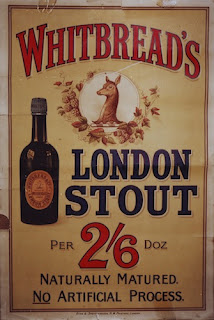Ads not shown when logged in
-
Automated Tracker

 Shut up about Barclay Perkins - The death of Keeping Porter
Shut up about Barclay Perkins - The death of Keeping Porter
Visit the Shut up about Barclay Perkins site
Porter. It went mild in the second half of the 19th century. Aged, or Keeping, Porter and the vats needed to make it disappeared. But how quickly? It just so happens I've unearthed a few relevant numbers.
Did I mention my Whitbread project? I must have. I'm trying to collect the set of their brewing records. The London Metropolitan Archives has every year from 1805 to 1975. I've only about 10 years missing for the Porter ones, mostly post-WW II. So I'm getting a unique insight into how Porter brewing mutated. Including the move away from aged Porter.
Let's quickly run through the development of Porter. Early Porters were the first beers (and they were Beers, not Ales) that London brewers had aged themselves. Before publicans or third parties had bought mild malt liquors and aged them in their own cellars. Spotting the public's liking for a bit of age, some brewers began ageing their Brown Beer. Not for immensely long periods, just six months or so. Enough to acquire the desired flavour. And Porter was born.
Initially, all Porter was aged. Until someone noticed that you could get the same aged effect by mixing a small quantity of beer that had been aged 12 months or more with fresh mild Porter. Two distinct types of Porter were brewed: Running Porter and Keeping Porter. What was the difference? Well, apart from being aged in enormous vats, Keeping Porter contained more hops. But the grists and gravity were identical.
In the 1840's, 25-30% of the Porter Whitbread brewed was K, or Keeping Porter. Which tallies pretty well with the recommendation of brewing manuals to mix around a third aged beer with fresh beer. As you'll see in the table below, there was a slight downward trend in the 1850's, and occasional years where far less Keeoping Porter was brewed, less than 10% or total Porter output.
The decline of Whitbread's Keeping Porter
Year
no. brews K
brewsize K
K total barrels
% K
KK
% KK
Total running Porter
% running Porter
total all Porter
Source:
Whitbread brewing records held at the London Metropolitan Archives
Notes:
1839, 1854 and 1862 quantities estimated from the number of brews
In the middle of the 1860's, there was a sudden and dramatic collapse in Whitbread's production of Keeping Porter, dropping from 17,000 barrels in 1865 to 5,500 in 1866. For the remaining years of the decade, there were a handful of brews. Until 1870, when the final four brews occurred and Whitbread's K disappeared forever.
How did Keeping Porter disappear? Remarkably quickly
More...
Similar Threads
-
By Blog Tracker in forum Blog Tracker
Replies: 0
Last Post: 07-10-2010, 16:00
-
By Blog Tracker in forum Blog Tracker
Replies: 0
Last Post: 17-09-2010, 07:16
-
By Blog Tracker in forum Blog Tracker
Replies: 0
Last Post: 17-07-2010, 07:21
-
By Blog Tracker in forum Blog Tracker
Replies: 0
Last Post: 21-04-2010, 08:21
-
By Blog Tracker in forum Blog Tracker
Replies: 0
Last Post: 14-03-2010, 07:06
 Posting Permissions
Posting Permissions
- You may not post new threads
- You may not post replies
- You may not post attachments
- You may not edit your posts
-
Forum Rules





 Reply With Quote
Reply With Quote